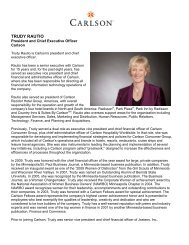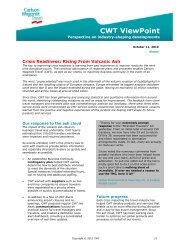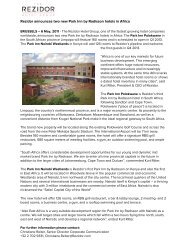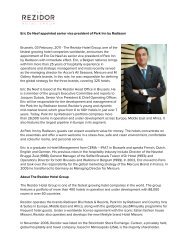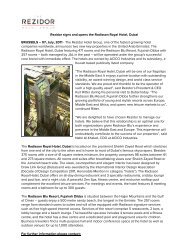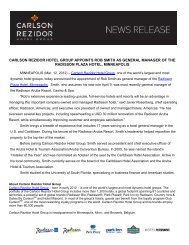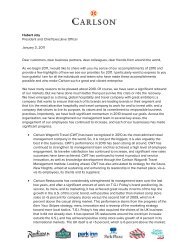Room for Savings: Optimizing Hotel Spend - Carlson
Room for Savings: Optimizing Hotel Spend - Carlson
Room for Savings: Optimizing Hotel Spend - Carlson
You also want an ePaper? Increase the reach of your titles
YUMPU automatically turns print PDFs into web optimized ePapers that Google loves.
There is, however, a risk associated with chainwide<br />
deals. In many cities where a preferred<br />
property is also available, travelers may be<br />
tempted to use the preferred chain and there<strong>for</strong>e<br />
dilute the volumes allocated to individual<br />
preferred properties. The hotel policy should<br />
there<strong>for</strong>e underline the procedure to follow<br />
when booking (i.e., choose preferred properties<br />
be<strong>for</strong>e preferred chains when both are<br />
available).<br />
travelers who might not accept fluctuating prices,<br />
difficulty in budgeting hotel costs, and a lack of<br />
clear-cut value brought by dynamic pricing<br />
(Figure 80).<br />
Flat-rate or dynamic pricing deal?<br />
Dynamic pricing agreements have long been a<br />
subject of debate among travel management<br />
professionals, mainly due to a lack of data to<br />
demonstrate the savings they can bring<br />
compared with negotiated flat rates. CWT<br />
there<strong>for</strong>e conducted in-depth case studies to<br />
discover just how well dynamic pricing deals can<br />
per<strong>for</strong>m.<br />
Dynamic pricing agreements provide a fixed<br />
percentage discount off a hotel’s fluctuating best<br />
available rate (BAR). While companies<br />
commonly accept dynamic pricing in chain-wide<br />
deals, they tend to prefer flat rates whenever<br />
they have the requisite volume <strong>for</strong> a propertylevel<br />
agreement.<br />
According to the CWT survey, only 24 percent of<br />
companies have signed property-level deals<br />
based on dynamic pricing, and among those<br />
companies, 90 percent have done so with fewer<br />
than 10 hotels, as shown in Figure 79. Among<br />
companies that have signed dynamic pricing<br />
agreements, 39 percent say they did so only<br />
because the hotel(s) would not negotiate a flat<br />
rate. Companies that have refused dynamic<br />
pricing proposals cite several reasons, including<br />
the need to monitor prices, a fear that the room<br />
rate would increase, potential resistance from






